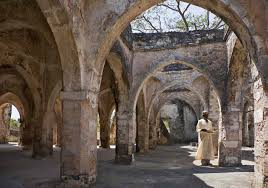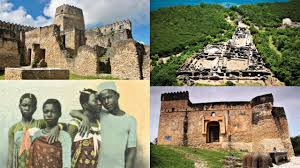Introduction
Imagine a string of vibrant, bustling cities along the East African coast where cultures from Africa, Arabia, Persia, and India intertwined to create a unique and thriving civilization. These were the Swahili city-states, the medieval metropolises that flourished between the 10th and 15th centuries. Known for their trade, architecture, and cosmopolitan culture, these city-states played a pivotal role in shaping East Africa’s history. Let’s dive into the fascinating world of the Swahili city-states and uncover their legacy.

Who Were the Swahili People?
The Swahili people are a blend of African, Arab, and Persian heritage, shaped by centuries of interaction along the East African coast.
The Origins of the Swahili Culture
The Swahili culture emerged around the 8th century, with Bantu-speaking communities adopting influences from Arab and Persian traders. This fusion gave rise to the Swahili language, a Bantu language enriched with Arabic vocabulary.
Geography of the Swahili Coast
The Swahili city-states stretched along the coast of East Africa, from modern-day Somalia to Mozambique, with offshore islands like Zanzibar, Pemba, and Kilwa playing prominent roles.
Key City-States
Some of the most notable city-states included Kilwa, Mombasa, Zanzibar, Lamu, and Malindi. Each city-state operated independently but shared cultural and economic ties.
Trade and Commerce in the Swahili City-States
Trade was the lifeblood of the Swahili city-states, connecting them to the vast Indian Ocean trade network.
The Indian Ocean Trade Network
Swahili merchants traded gold, ivory, and slaves from the African interior for spices, textiles, porcelain, and beads from Arabia, Persia, and India. These city-states served as a bridge between Africa and the rest of the world.

Wealth and Prosperity
The wealth generated from trade allowed the Swahili elites to build luxurious homes and mosques, many of which were adorned with imported materials like Chinese porcelain and Persian rugs.
Swahili Architecture: A Blend of Cultures
The architecture of the Swahili city-states reflects their multicultural heritage, blending African, Islamic, and Persian influences.
Coral Stone Constructions
Buildings were often made from coral stone, a readily available resource. Mosques, palaces, and homes featured intricate carvings and elaborate doorways, showcasing skilled craftsmanship.
Iconic Structures
Kilwa Kisiwani’s Great Mosque and the Husuni Kubwa palace are prime examples of Swahili architectural ingenuity and cultural synthesis.
Religion and Society in the Swahili City-States
Islam played a central role in Swahili culture, shaping their society, governance, and daily life.
The Spread of Islam
Arab traders introduced Islam to the Swahili coast as early as the 8th century. By the 12th century, Islam was firmly established, influencing the city-states’ laws, education, and culture.
A Cosmopolitan Society
The Swahili city-states were remarkably cosmopolitan, with a diverse population that included Africans, Arabs, Persians, Indians, and later, Europeans. This diversity fostered tolerance and cultural exchange.
Also read : Spirituality vs. Religion: Understanding the Differences and Finding Common Ground
Swahili Language and Literature
The Swahili language, a unifying factor for the region, remains one of the most widely spoken languages in Africa today.
Development of the Swahili Language
Rooted in Bantu, the Swahili language incorporates words from Arabic, Persian, Portuguese, and more, reflecting its multicultural origins.
Swahili Literature
Oral poetry and prose flourished in the Swahili city-states. Works like the Utendi wa Tambuka (The Story of Tambuka) highlight the rich literary tradition of the Swahili people.
Challenges and Decline
No civilization lasts forever, and the Swahili city-states faced numerous challenges that led to their decline.
Invasions by Foreign Powers
The arrival of the Portuguese in the late 15th century disrupted the Indian Ocean trade network. They attacked and looted key city-states, undermining their wealth and power.
Shifting Trade Routes
Over time, shifts in global trade routes further marginalized the Swahili city-states, leading to their eventual decline.
Legacy of the Swahili City-States and Culture
Despite their decline, the Swahili city-states left an enduring legacy that continues to influence East African culture and identity.
Cultural Continuity
Elements of Swahili culture, including its language, architecture, and traditions, remain integral to the identity of coastal communities in East Africa.
Historical Significance
The Swahili city-states highlight Africa’s vital role in global history, particularly in trade and cultural exchange during the medieval period.
Rediscovering the Swahili City-States and Culture
Modern archaeology and historical research are uncovering new insights into the Swahili city-states.
Archaeological Discoveries
Excavations at sites like Kilwa Kisiwani and Gede have revealed artifacts, ancient structures, and evidence of extensive trade networks.
Preserving Swahili Heritage
Efforts to preserve Swahili sites as UNESCO World Heritage Sites ensure that this rich history is not forgotten.
Why Their Story Matters
The history of the Swahili city-states offers valuable lessons about cultural diversity, resilience, and the interconnectedness of civilizations.
Celebrating African Contributions
By exploring the Swahili city-states, we celebrate Africa’s role as a hub of innovation and cultural exchange in the medieval world.
Lessons for Today
The cosmopolitan nature of the Swahili city-states reminds us of the importance of tolerance and collaboration in building thriving societies.
Conclusion
The Swahili city-states were more than just trading hubs; they were centers of culture, innovation, and interaction that bridged continents. From their magnificent architecture to their bustling trade networks, these medieval metropolises embody the richness of East Africa’s heritage. By rediscovering their story, we not only honor the past but also draw inspiration for a more inclusive and interconnected future.
Also Africa: Affiliate Marketing: What It Is and How to Get Started
FAQs
Q1: What were the Swahili city-states?
The Swahili city-states were independent coastal cities along East Africa that thrived from the 10th to 15th centuries, known for trade and cultural exchange.
Q2: Where were the Swahili city-states located?
They stretched along the East African coast, from modern-day Somalia to Mozambique, including islands like Zanzibar and Kilwa.
Q3: What role did trade play in Swahili city-states?
Trade was central to their economy, connecting them to the Indian Ocean trade network and bringing wealth through the exchange of goods like gold, ivory, and spices.
Q4: Why did the Swahili city-states decline?
Their decline was due to Portuguese invasions, shifts in global trade routes, and competition from other trading powers.
Q5: What is the legacy of the Swahili city-states?
Their legacy lives on in Swahili language, architecture, and culture, which continue to influence East African identity today.


